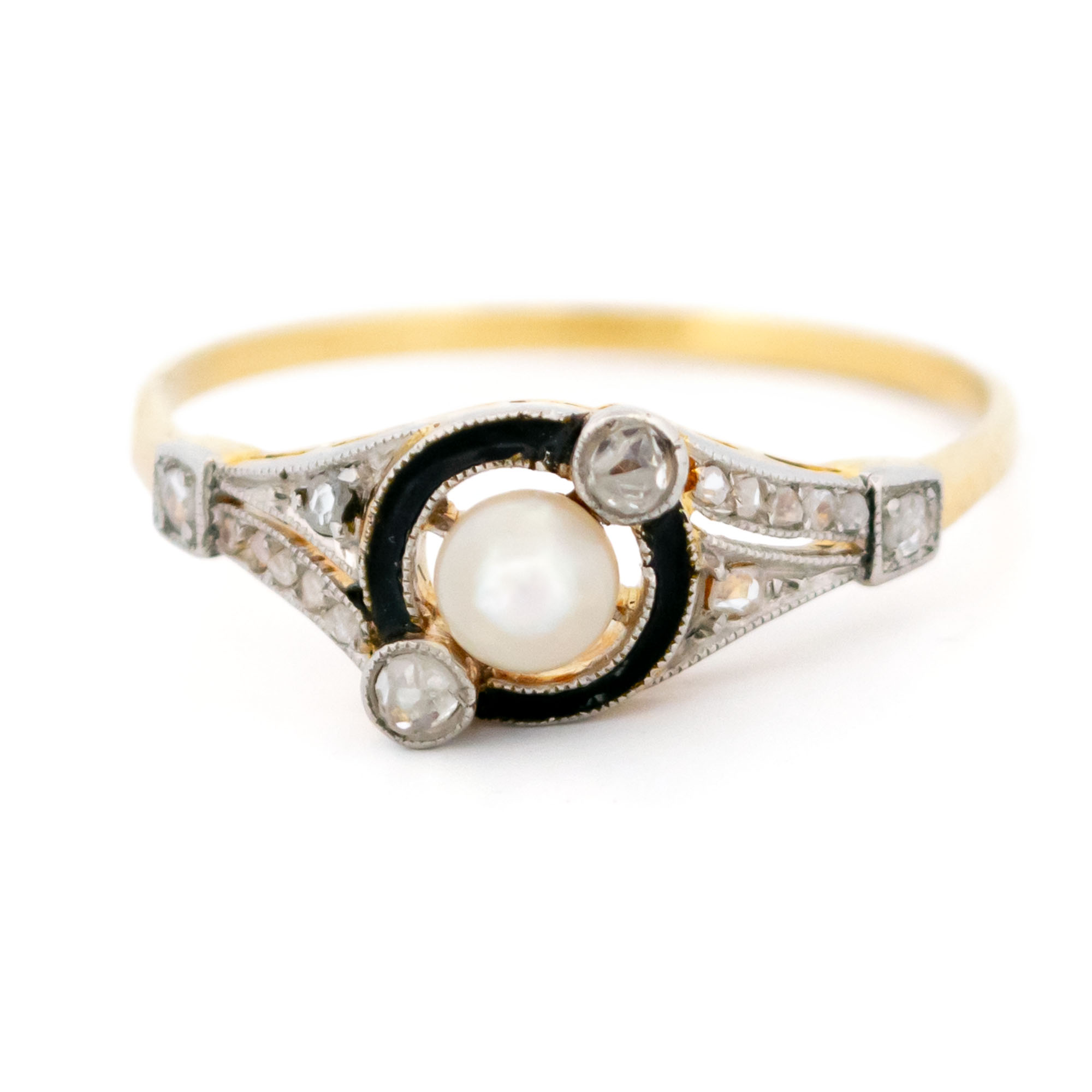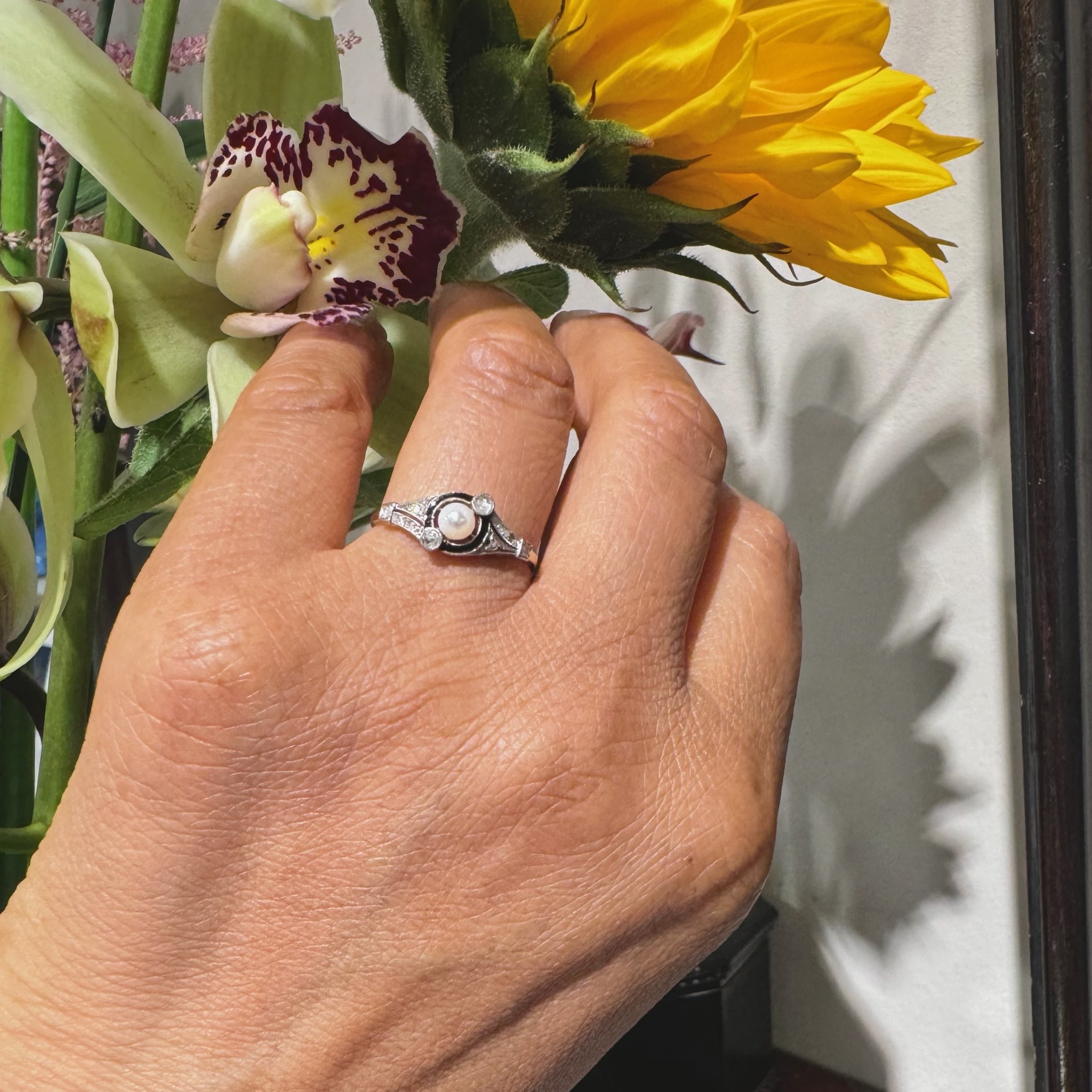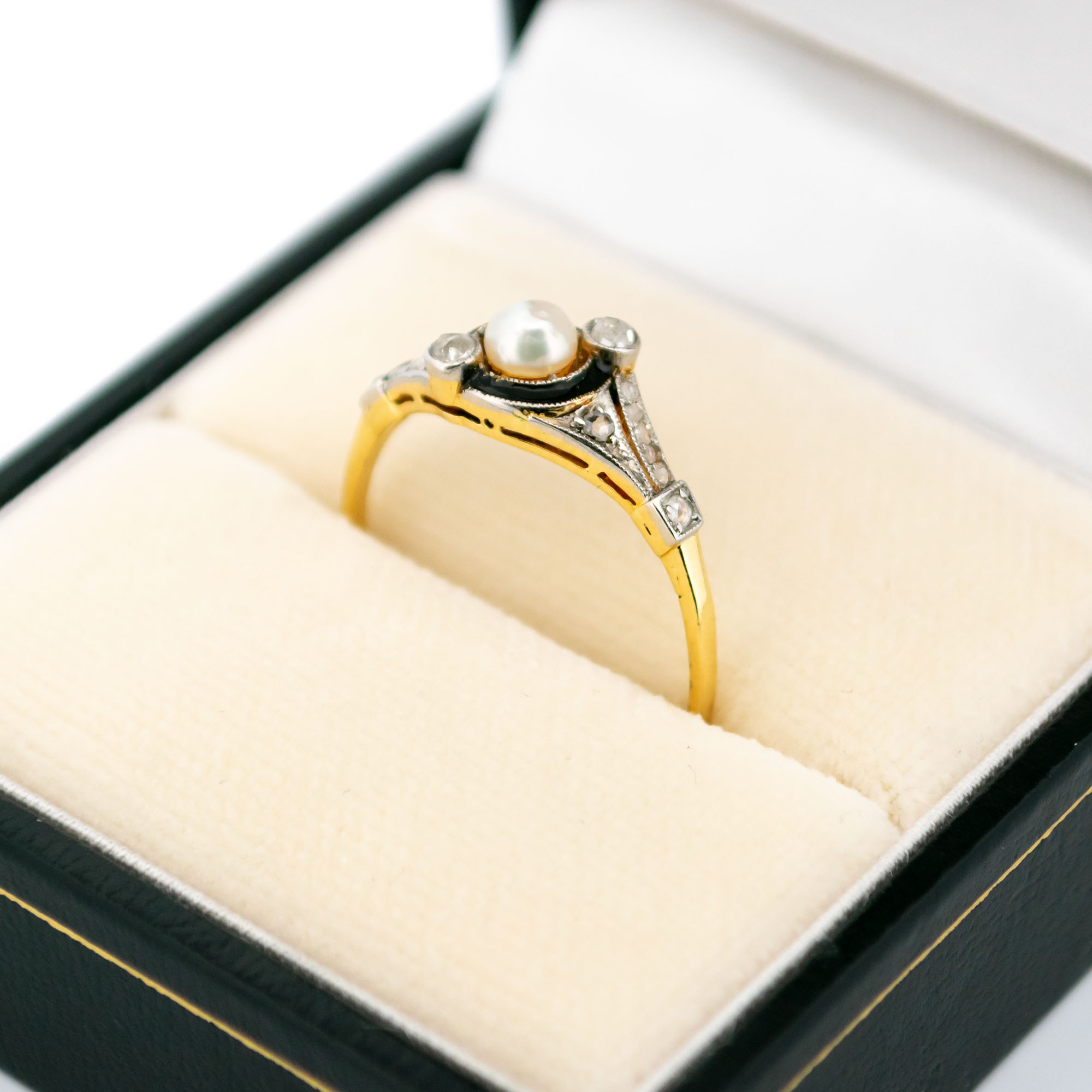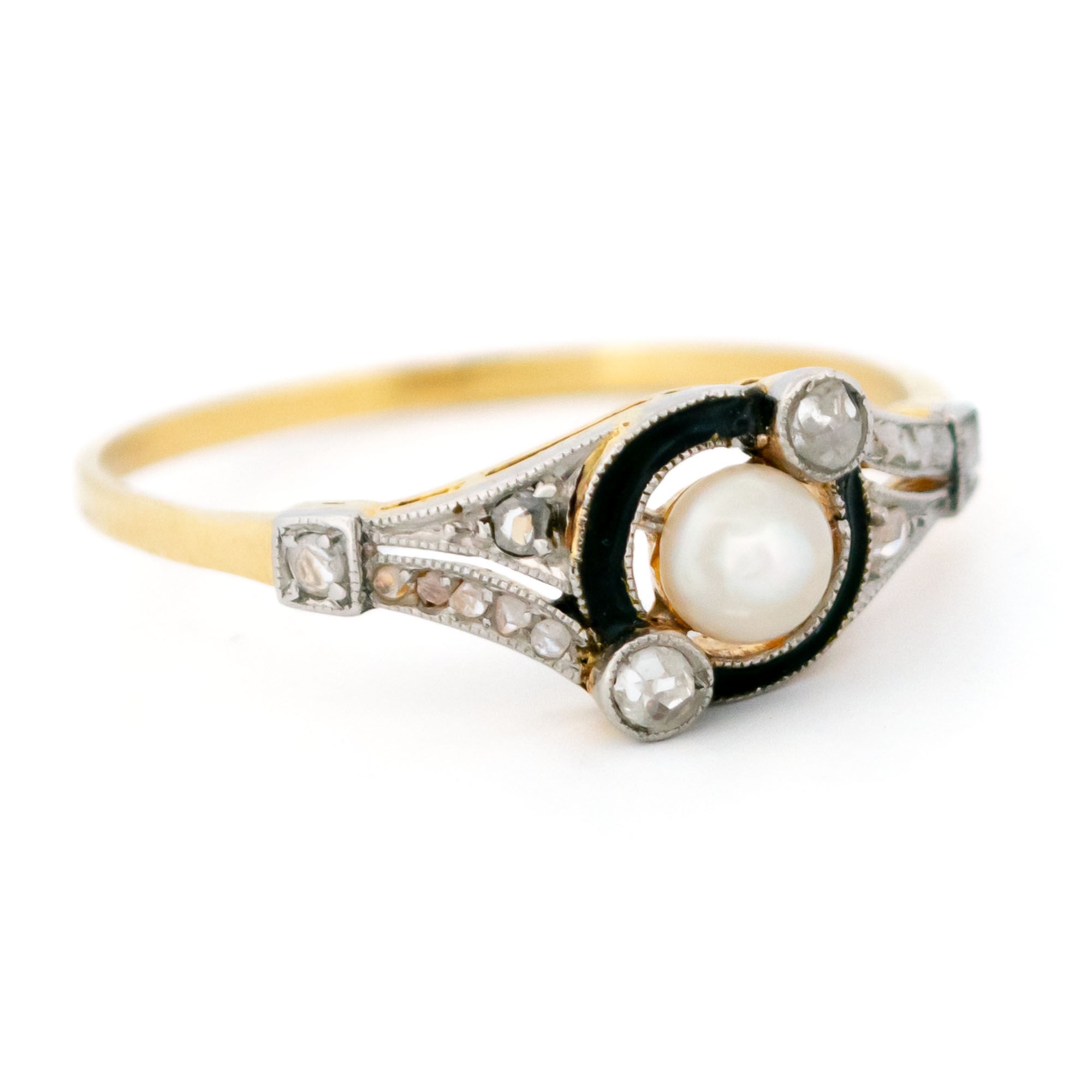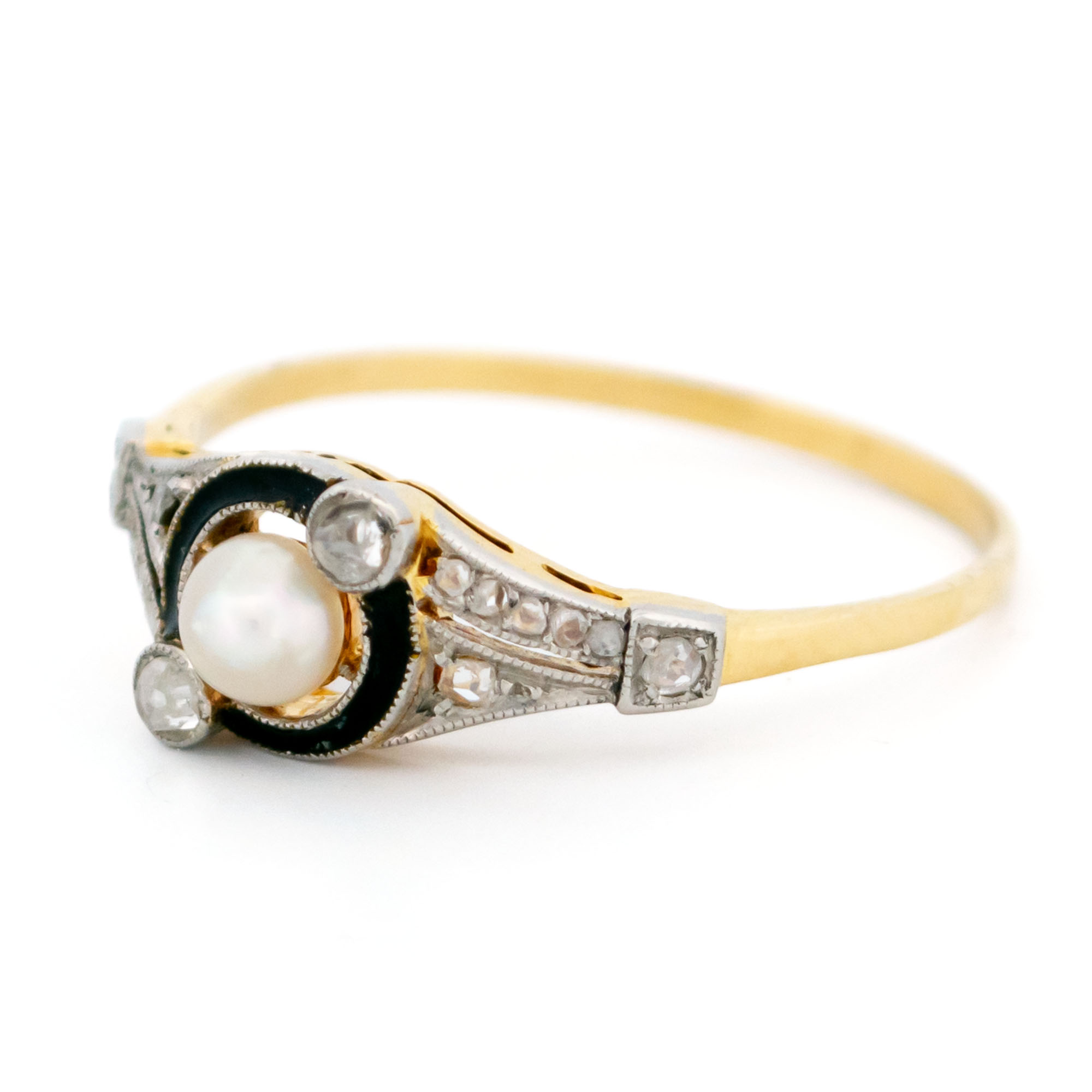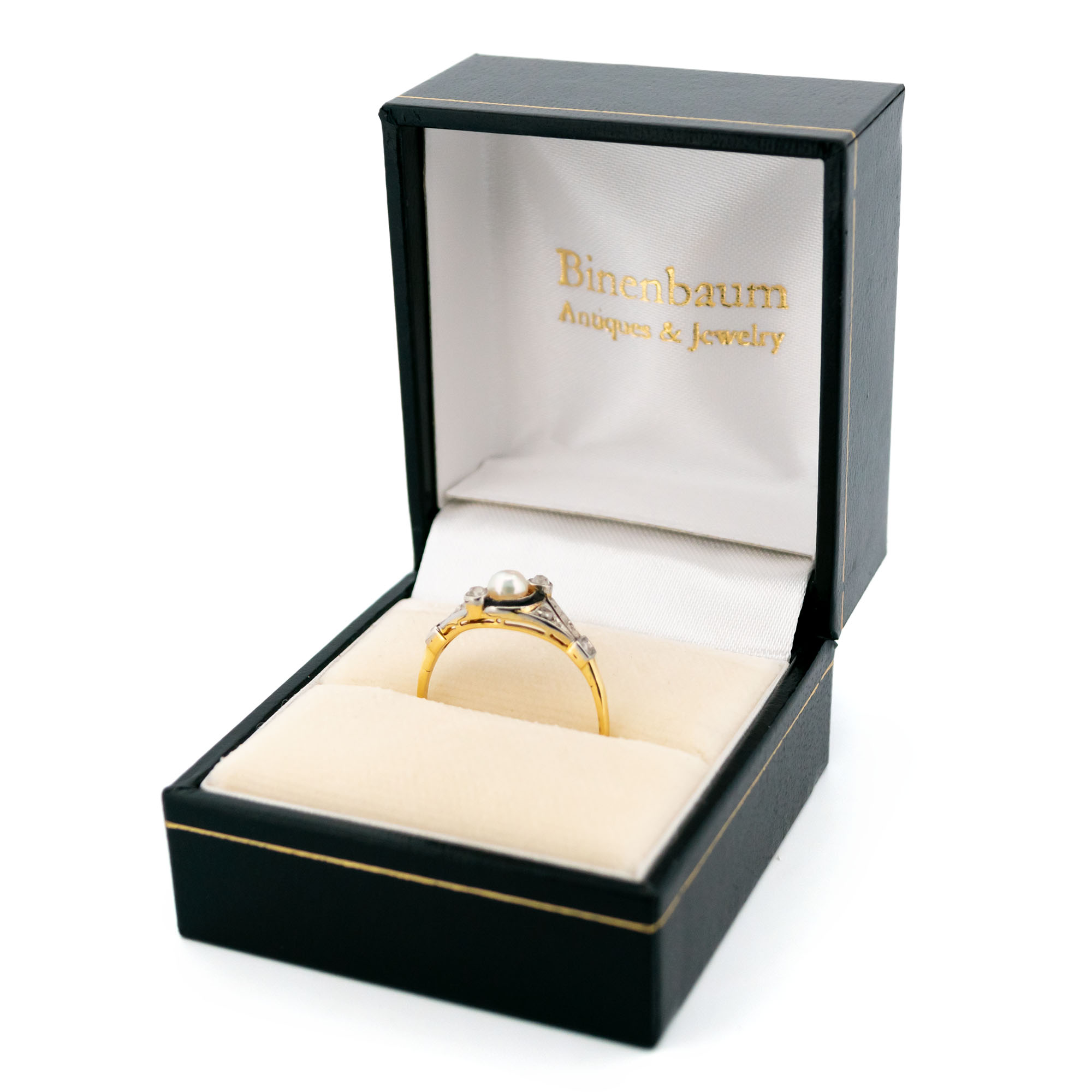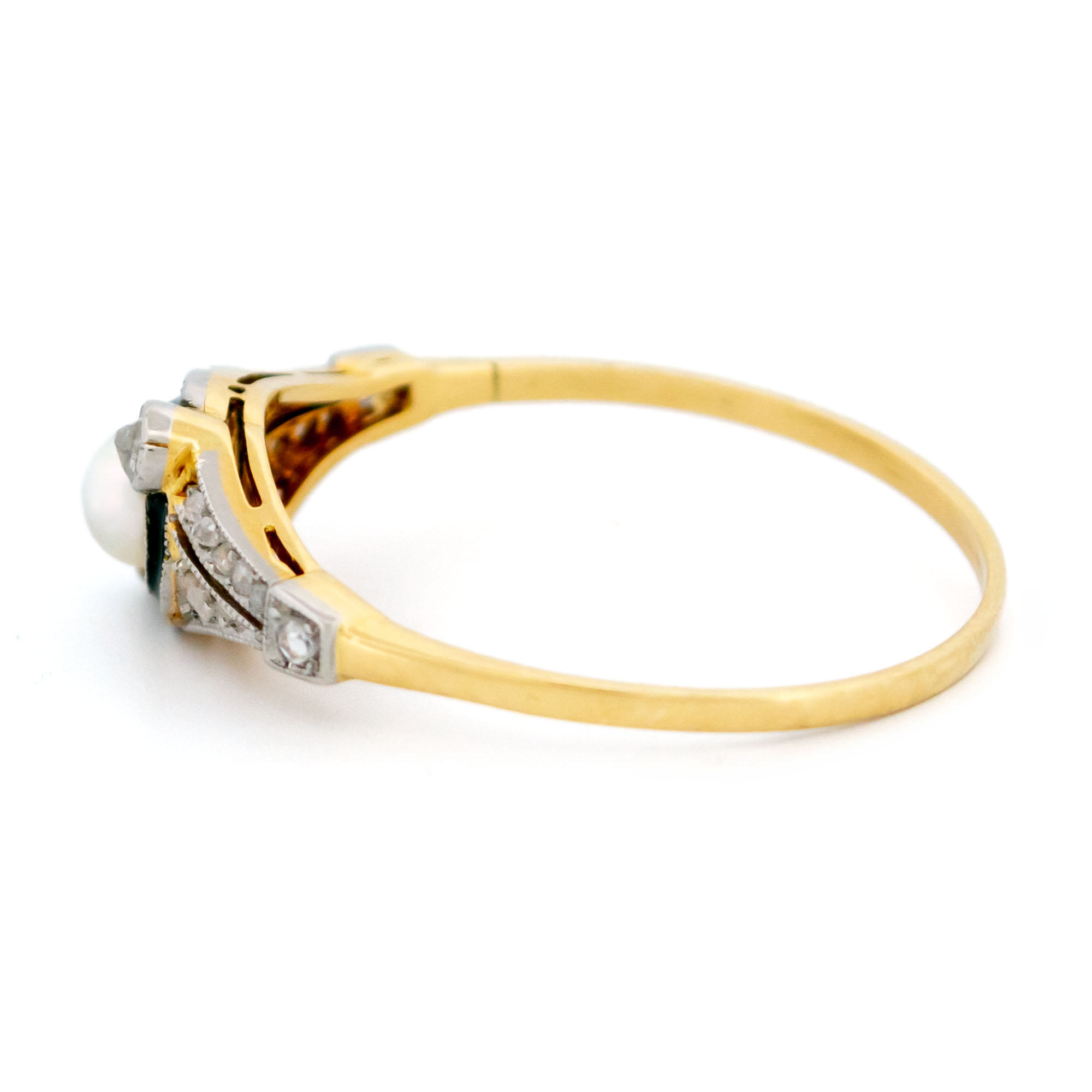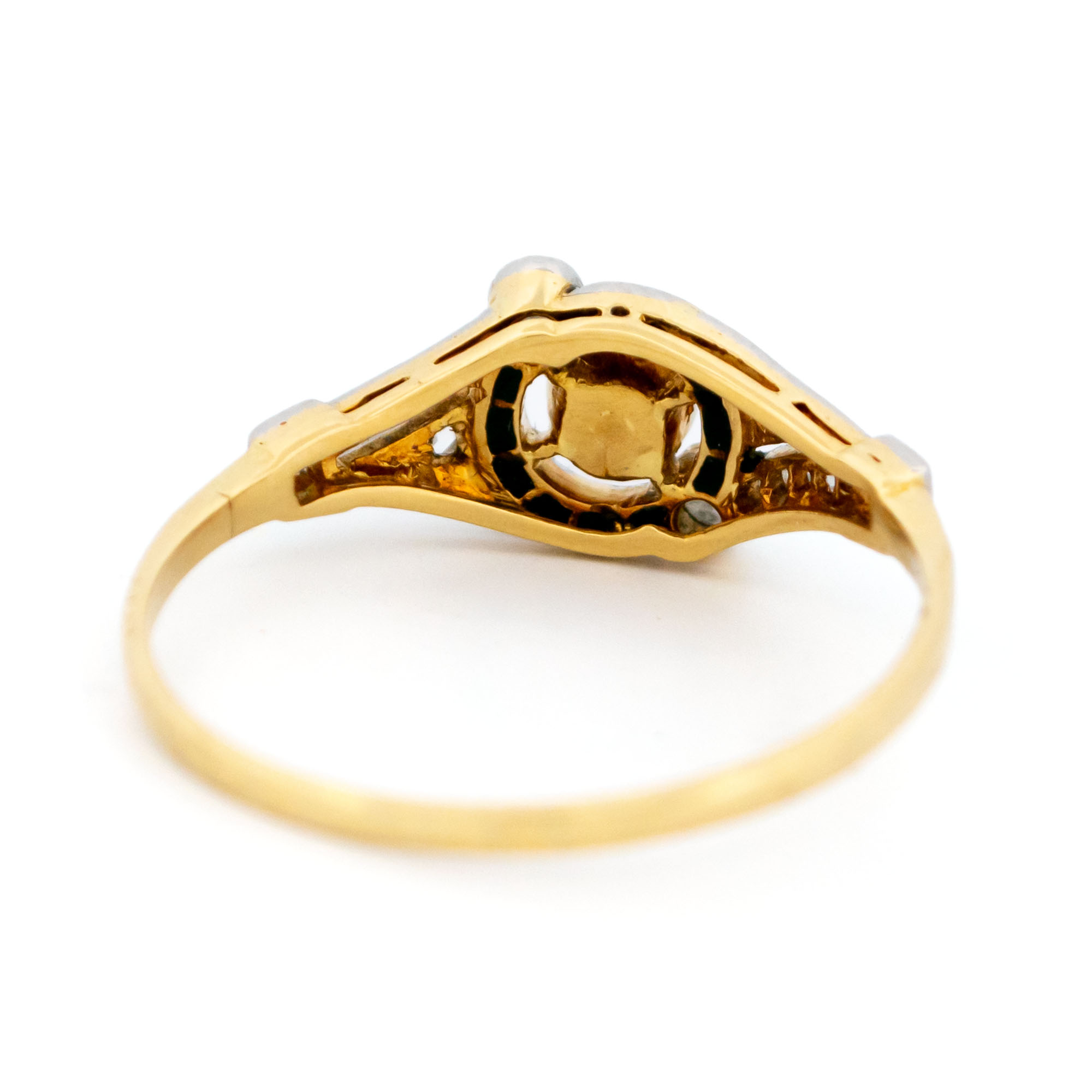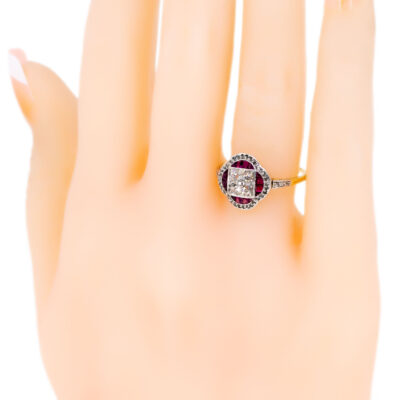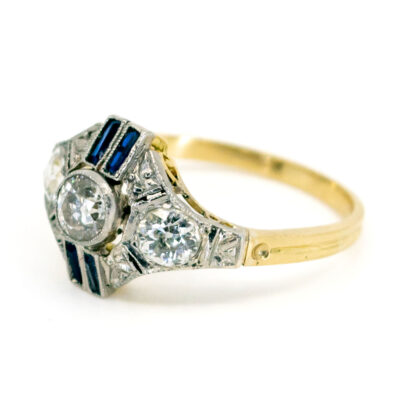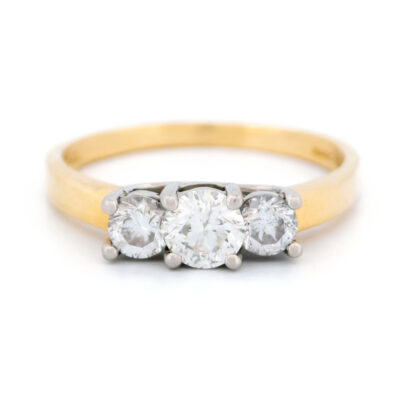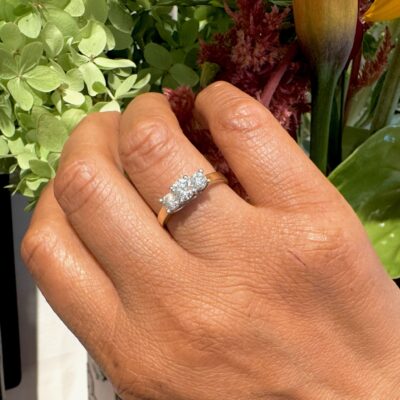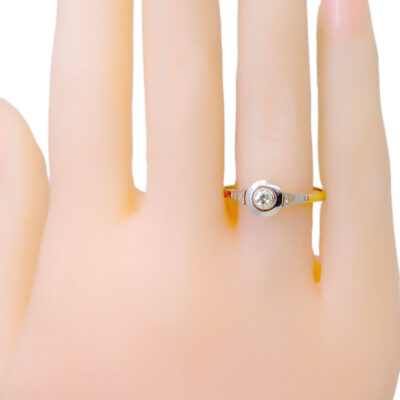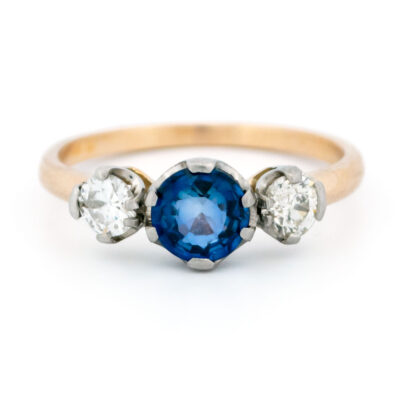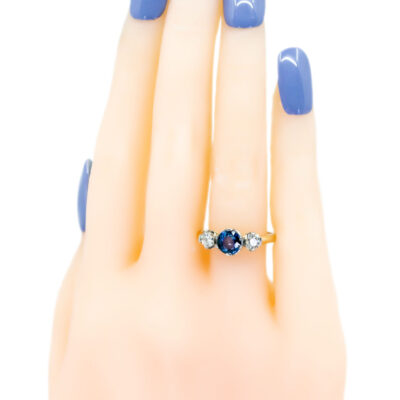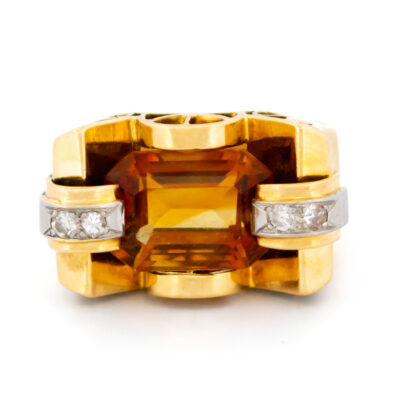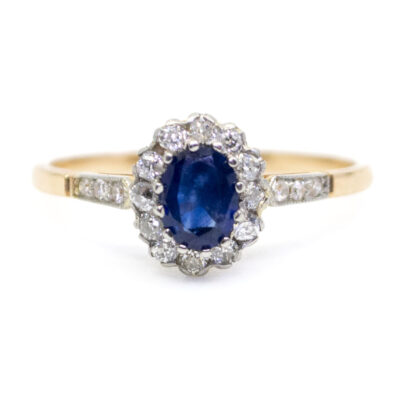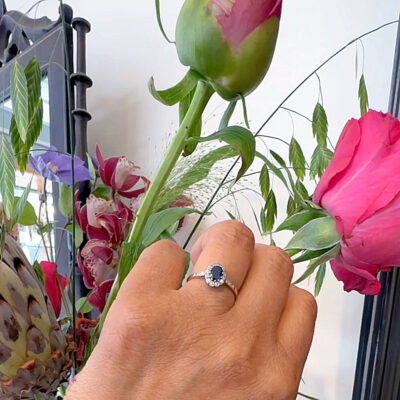This Art Deco ring exudes vintage charm, crafted in 18k yellow gold with platinum accents. At its center, a 4mm cultured pearl is framed by a bold black enamel halo, flanked by rose-cut diamond accents. The intricate milgrain detailing and delicate rose-cut diamonds along the platinum shoulders create a refined, timeless look.
Videos
Details: 4mm cult. Pearl, Enamel, Rose-cut diamond, 18k, Platinum Ring.
Size: 17.93 NL / 56.3 FR / 7¾ US / P UK, sizeable (Within reason. Contact seller for information).
Weight in grams: 1.9.
Condition: Very good condition – slightly used with small signs of wear.
Shipping and Pickup: This beautiful piece ships from our store located in the center of Amsterdam, The Netherlands. We offer both registered shipping and local pickup at our store. In the case of local pickup, any applicable shipping costs will be refunded.
About Us: Add some sparkle to your style with Binenbaum.com. We offer a stunning selection of antique and vintage jewelry that you won’t find anywhere else. From timeless rings and dazzling necklaces to unique brooches, we have something for every taste and occasion. Visit our website today and treat yourself to a piece of history.
| Design Era | |
|---|---|
| Design & Historical Context | Art Deco jewelry, also known as Jazz Age jewelry, became popular in the 1920s and remained in style through the 1930s. It was named after the Exposition International des Arts Décoratifs et Industriels Modernes, a exhibition held in Paris in 1925 that was largely dedicated to the jewelry arts. This style was inspired by a variety of cultural and artistic movements, such as Oriental, African, and South American art, as well as Cubism and Fauvism. Art Deco jewelry is known for its sharp, straight lines and emphasis on modernity and the machine age. During the Art Deco era, there were significant improvements in diamond cutting techniques, which made diamonds more radiant and sparkling than ever before. This, along with increased prosperity, allowed more people to afford diamond jewelry and engagement rings. Additionally, new casting techniques made it possible to produce more intricate and detailed settings. Art Deco jewelry was not only fashionable but also reflected the social and cultural changes of the time. The bold, modern design of Art Deco jewelry reflected the liberation and empowerment of women during the 1920s and 1930s. Today, Art Deco jewelry is highly sought after by collectors and is often featured in museum exhibitions and high-end auctions. |
| Key Materials | |
| Materials & Craftsmanship | Pearl: The Gem of Elegance and Purity Pearls, with their natural luster and timeless beauty, are one of the most revered gemstones in the world. Unlike other gems, pearls are organic, formed within the soft tissue of mollusks like oysters and mussels. Their formation process results in a smooth, round gem with a soft, iridescent glow, often referred to as the pearl essence. Historically, pearls have been a symbol of purity, wisdom, and wealth. In ancient Rome, they were considered the ultimate status symbol, while in ancient China, pearls were believed to protect against fire and dragons. During the Renaissance, pearls were so highly valued that they were reserved for royalty and nobility, symbolizing perfection and integrity. In modern jewelry, pearls are cherished for their classic elegance and versatility. They are commonly found in a range of colors, from the traditional white and cream to rare black, pink, and golden hues. Pearls are often strung into necklaces, set into earrings, or used as delicate accents in rings and bracelets. Their softness, with a Mohs hardness of 2.5 to 4.5, requires gentle care, but their beauty and sophistication are unmatched. Pearls are more than just a gem; they are a symbol of grace, purity, and timeless style. Their natural origins and understated elegance make them a beloved choice for jewelry that exudes refinement and sophistication. Enamel: The Artful Fusion of Color and Craftsmanship Enamel is a decorative technique that has been used in jewelry for centuries, known for its ability to bring vibrant color and intricate designs to metal surfaces. Created by fusing powdered glass to metal at high temperatures, enamel can produce a wide range of colors, from bold and opaque to translucent and delicate. Historically, enamel has been used across various cultures, from ancient Egypt and China to Renaissance Europe, to create stunning works of art in jewelry, religious artifacts, and decorative objects. The intricate process of enameling, which requires skill and precision, has made it a prized technique among artisans. In contemporary jewelry, enamel is appreciated for its versatility and ability to enhance the beauty of metalwork. It can be used to add a pop of color to a piece, create detailed imagery, or produce a smooth, glossy finish that complements gemstones and precious metals. Enamel not only adds a burst of color and creativity to jewelry but also represents the craftsmanship and artistry behind each piece. Whether in modern or vintage designs, enamel brings a unique and timeless appeal to jewelry, making it a cherished choice for those who appreciate fine detail and vibrant hues. Rose-cut diamond: The Vintage Gem of Romance and Light Rose-cut diamonds are a beautiful and romantic choice in the world of jewelry, known for their distinctive dome-shaped appearance and soft, glowing sparkle. This antique diamond cut, dating back to the 16th century, features a flat bottom and a domed top covered in triangular facets that resemble the petals of a rosebud—hence the name. Historically, rose-cut diamonds were highly prized during the Georgian and Victorian eras, often used in jewelry pieces meant to be worn in candlelight, where their gentle sparkle added a warm, intimate glow. Unlike modern brilliant cuts, which are designed for maximum fire and brilliance, rose-cut diamonds offer a more subdued, yet enchanting, reflection of light. In modern jewelry, rose-cut diamonds are cherished for their vintage appeal and unique charm. Their flat base and shallow profile make them perfect for creating low-profile, elegant designs that sit close to the skin, such as in rings, pendants, and earrings. Rose-cut diamonds are often used in vintage-inspired and bespoke pieces, where their historical elegance adds a touch of timeless romance. Rose-cut diamonds are more than just a gemstone choice; they are a symbol of understated beauty and classic romance. Their soft, luminous sparkle and antique allure make them an ideal choice for jewelry that tells a story and captures the essence of a bygone era. 18k: The Perfect Balance of Luxury and Durability 18k gold is a luxurious and highly sought-after material in the world of fine jewelry, known for its rich color, durability, and value. The 18k refers to the purity of the gold, indicating that it is composed of 75% pure gold and 25% alloyed metals, such as copper, silver, or palladium. This combination provides the perfect balance between the softness of pure gold and the strength needed for creating durable jewelry. Historically, gold has been prized for its beauty and rarity, symbolizing wealth, power, and status across various cultures and civilizations. 18k gold has been a preferred choice in fine jewelry for centuries due to its ideal blend of purity and strength, offering a radiant gold color that is more vibrant than lower karat golds while still being hard enough for everyday wear. In modern jewelry, 18k gold is favored for its versatility and its ability to enhance the appearance of gemstones. It is available in several colors, including yellow, white, and rose gold, depending on the metals used in the alloy. Each color has its unique appeal: Yellow Gold: The classic choice, offering a warm, rich hue that pairs beautifully with a wide range of gemstones and complements all skin tones. White Gold: A sleek, modern option that resembles platinum or silver but with the strength and luxury of gold. It is often rhodium-plated to enhance its reflective surface. Rose Gold: A romantic, pinkish hue that has gained popularity for its vintage charm and contemporary appeal, achieved by alloying gold with copper. 18k gold is commonly used in engagement rings, wedding bands, earrings, necklaces, and bracelets, where its balance of durability and beauty makes it ideal for both intricate designs and simple, elegant pieces. The alloy's added strength ensures that jewelry can withstand daily wear while maintaining its luster and shape. 18k gold is more than just a material; it is a symbol of refined taste and enduring value. Its perfect blend of luxury and practicality makes 18k gold a timeless choice for those who seek the beauty of high-purity gold without sacrificing durability. Whether in classic or modern designs, 18k gold jewelry offers a radiant and lasting expression of elegance and sophistication. Platinum: The Metal of Endurance and Prestige Platinum, a rare and precious metal, is renowned for its exceptional strength, purity, and enduring beauty. With its naturally white luster and remarkable resistance to tarnish and corrosion, platinum has become synonymous with luxury and durability in the world of fine jewelry. Historically, platinum has been valued for its rarity and unique properties. Ancient Egyptians and Pre-Columbian civilizations used platinum in their ceremonial jewelry, though its full potential wasn’t realized until the 18th century. By the 20th century, platinum became the metal of choice for royalty and high society, particularly in engagement rings and fine jewelry, due to its ability to securely hold precious gemstones. In modern jewelry, platinum is highly prized for its hypoallergenic properties and its ability to withstand daily wear without losing its brilliance. Its density and weight give it a luxurious feel, while its purity—often 95% pure—makes it an ideal setting for diamonds and other gemstones. Platinum's naturally white sheen enhances the sparkle of gems, and its durability ensures that jewelry pieces crafted in platinum can be passed down through generations. Platinum is more than just a metal; it is a symbol of strength, rarity, and timeless elegance. Its unmatched durability and sophisticated appearance make it the ultimate choice for those seeking jewelry that lasts a lifetime while maintaining its prestige and beauty. |
| Size | |
| Gender | |
| Weight (in grams) | 1.9 |
| Condition | Very good condition – slightly used with small signs of wear |
By following these tips, you can enjoy your precious jewelry for many years to come.
Related Products
-
Diamond Ruby 18k Platinum Quatrefoil Ring 13971-8615
€ 1.995,00 VAT incl. (where applicable) -
Diamond 14k Trilogy Ring 16902-9008
€ 1.695,00 VAT incl. (where applicable) -
Diamond Platinum Sapphire 14k Deco Ring 11510-2295
€ 3.395,00 VAT incl. (where applicable) -
Diamond 14k Platinum Trilogy Ring 16360-8818
€ 3.495,00 VAT incl. (where applicable) -
Diamond 14k Platinum Halo Ring 254-1403
€ 1.495,00 VAT incl. (where applicable) -
Diamond Sapphire 14k Platinum Trilogy Ring 14408-5114
€ 3.295,00 VAT incl. (where applicable) -
Citrine Diamond 18k Platinum Tank Ring 17360-9183
€ 2.995,00 VAT incl. (where applicable) -
Diamond Sapphire 14k Platinum Cluster Ring 17315-4977
€ 1.895,00 VAT incl. (where applicable)
- Home
- Collection
- Fine Jewelry
- Silver Jewelry
- Silverware
- Boxes
- Candlesticks
- Salt and pepper shakers
- Miniatures
- Salt cellars
- Spoon Set
- Condiments
- Frames
- Napkin Ring
- Spoon
- Oddities
- Cups
- Vases
- Cutlery
- Serving Spoon And Cake Server
- Candlesticks
- Baskets
- Hanukkiah
- Spice Tower
- Yad
- Tea Set
- Sugar Castor
- Napkin Rings
- Wine Bottle Coaster
- Wine Stopper
- Tea Pot
- Jugs
- Rattles
- Hip Flask
- Miscellaneous
- Rings 💍
- About
- Contact
